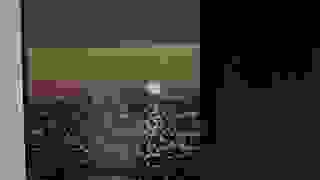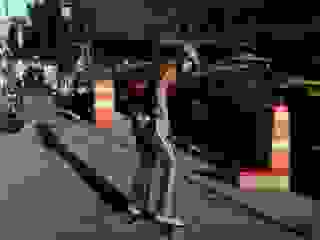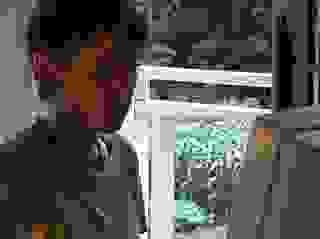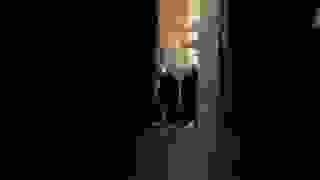Lasting Forever
Online Video Screening, 01.03.–24.04.2022
Still: Video by Melissa Dyne, Emma Hedditch and Khaela Maricich.
There are two silhouetted figures, one is facing away from us on the left and the other on the right side of the frame is looking to the left. Between them, there is a bright light pointing towards the camera and a close-up of a woman’s face in profile leaning across from right to left with her right arm reaching out. The aspect ratio of the image is 4:3 and the quality is grainy.
Still: Video by Ethan Means.
The image is recorded from a computer screen and shows the silver frame of the computer on the left, and next to that a pixelated image of a sunset at the ocean, with the sun which is white almost touching the horizon. The right side of the image is a strip of black. Everything is on a slight angle. The aspect ratio of the image is 16:9 and the quality is clear.
Still: Nicole Lowe, 2021.
A person with long dark hair, wearing a white bathrobe. They are looking towards the camera. The image is lit from the bottom of the screen. The light is refracting on the lens creating a soft light effect across the whole image.
Still: Emma Hedditch, 2000.
In the foreground is a rose bush with red roses blooming, and the surrounding is a green field.
Still: Henriette Heise, 2016.
A medium close up of a television being repaired from behind. Two hands are entering the left of the frame holding up a component of the television and a soldering iron.
Still: Lilia Paskewicz, 2000.
A person on a skateboard, almost in profile and looking down. Their body is casting a long shadow to the left of the image and they are positioned between two large orange construction bollards.
Still: Andrea Hufner, 2000.
A medium close up shot of a person on the left looking at a computer screen on the right side. In the background is an open window, looking out at a garden with high green plants.
Still: Hyojee Choi, 2021.
An evenly lit doorway surrounded on the left and right with dark space. Through the doorway we see a person doing a forward bend, touching the floor with the tips of their fingers. Behind them is a large comic book style painting.
Still: Emma Hedditch, Lydia Okrent, Mariana Valencia, 2016.
Two people shot in medium close up. Both are wearing white t-shirts, they are dancing together, both facing the same direction and staring off to the left of the frame.
01.03.–24.04.2022
Online Video Screening
Curated by
Emma Hedditch
With contributions by
Dana Bishop-Root, Ginger Brooks-Takahashi, Hyojee Choi, Melissa Dyne, Emma Hedditch, Henriette Heise, Andrea Hufner, Nicole Lowe, Khaela Maricich, Ethan Means, Lydia Okrent, Lilia Paskewicz, Eileen Simpson, Mariana Valencia
The shots in Lasting Forever are placed alongside each other in the sequence because they don’t have a beginning or an end, in the sense that completed video works do. The frame and its duration are what we see and are the video program. These and other constraints are linked together in their being placed alongside each other. All of the sounds are from the world of the image, which includes a home office, a live music venue, a bathroom, a store being renovated, a kitchen, an exterior of a corner store, a traffic intersection all either in North America or Northern Europe. The viewer is encouraged to watch the program alongside their own music so as to link them further and make some magic.
Figures enter the frame and leave it, from side to side, and sometimes come towards the camera obscuring the lens. There are diagonal compositions, close-ups, long takes, jump cuts, refracted light, focus shifts, static and moving shots. You might notice some costumes or props that are time-specific, which in addition to the image quality give an indication of what era they are made in. The videos span 22 years, from 1999 to 2021. That is roughly the same period of time I have known Jimmy Robert, whose exhibition this program was made for. It is not a reflection of that relationship, but it is a staying in character, staying in the character of our capacity and incapacity to relate to each other, it’s both. Like spatial and temporal continuity in a narrative film, which can only be maintained with a great deal of organising, consideration, and trickery. And then sometimes we choose discontinuity and less force.
Some of the videos were made as correspondences in response to an instruction (which is similar to how a lot of film and video works are directed) or a request to record something motivated by a particular action, such as video somebody doing something for the first time, video a person at a computer, make a video motivated by light or scale. I have tended to notice looks between people, and reactions to something happening inside and off-screen.
The videos are gathered from a relatively accessible place to me, from tapes and files that I have and digitised from these tapes. They are loosely authored between the camera person and the subject. I am describing them as such, so as to not inflate them or change their status or take them out of time, but I understand that any such reframing will inevitably do that.
-
Emma Hedditch
(b. 1972, Great Britain) lives in New York. Hedditch focuses on daily practice, materiality and the dissemination of knowledge as political action. Hedditch has been a member of the Cinenova Working Group (1999-present), Copenhagen Free University (2001-2008), No Total, a site for performance (2012-2017), and Coop Fund (2018-present). Hedditch teaches film and video at the College of Staten Island and Cooper Union.








